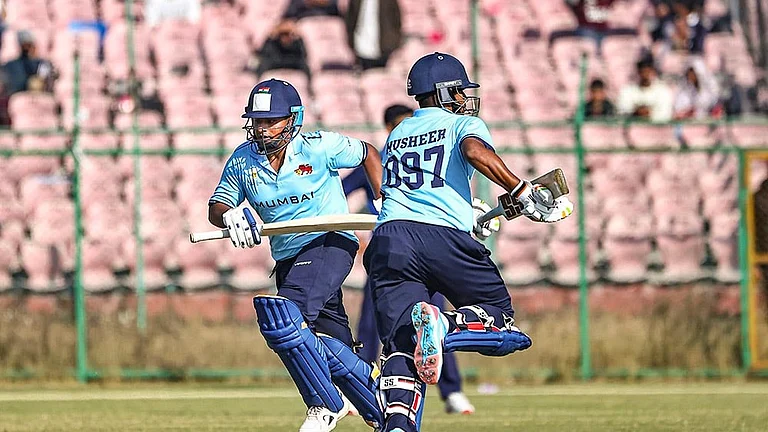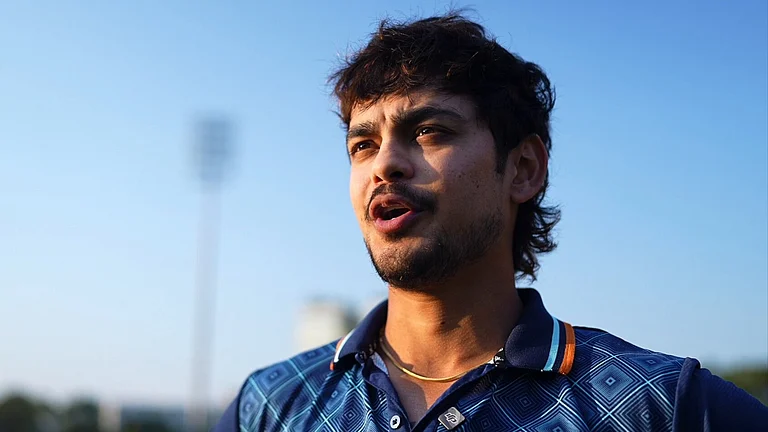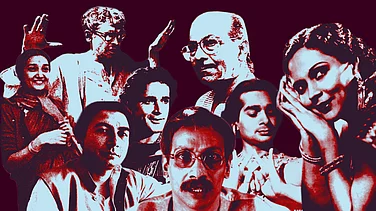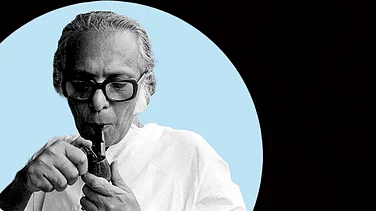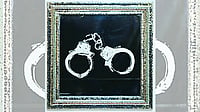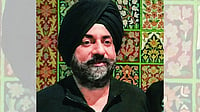He must have done good deeds in past life,
Or God truly is being kind to him.
Glow on young man’s face indicates,
His funeral bier would be lifted in his youth!
This is a loose translation of Last Ride, a hit song written and performed by Shubhdeep Singh Sidhu (1993-2022), better known as Sidhu Moosewala. It was released two weeks before the Punjabi rapper-turned-politician was shot dead on May 29, near his native village of Moosa in Punjab’s Mansa district. He was 28. Nearly two months later, his aficionados continue to throng Moosa, which was a nondescript village until a few years ago. Many believe Moosewala not only brought limelight to his village, but also raised the profile of the Punjabi music industry with his meteoric rise to stardom in a career that spanned just five years.
Big crowds wait outside his newly-built palatial house, which resembles a haveli, to meet his grieving parents. Moosewala’s father, Balkaur Singh, comes out of the mansion to meet the crowds at regular intervals each day. Further away, people pay homage to the slain singer at the family’s farm, where his mortal remains were consigned to fire. Fans have built an impromptu shrine at the spot in the middle of paddy fields, which has been boxed with brickwork. Someone has installed Moosewala’s bust, which is regularly garlanded by visitors. Flags imprinted with Moosewla’s pictures too have been planted nearby. Many can be seen bowing down to pay obeisance before their idol and even offering money.
Even though a huge body of work, including unreleased songs, is good enough to keep him alive in popular memory, Moosewala’s mother has appealed that fans plant trees in memory of their sole offspring. While many visitors have been planting trees and flowers in Moosewala’s name at the cremation site, others have also been dutifully fulfilling the mother’s wish across Punjab and beyond. “Following the appeal by Moosewala’s mother, I am selling plants at half-price. In my entire life, I never saw this kind of resolve among people for planting trees,” says Sona Singh, who runs a mobile nursery and is stationed on a road near Moosewala’s memorial these days. “We want our brother to stay alive in these trees.”

Talk to any random visitor here or local villagers and they will tell you that despite fame and fortune, Sidhu was a humble person who inspired many to take pride in rural life and farming. In fact, the singer would boastfully proclaim that unlike other celebrated Punjabi singers he chose his village over Canada, Mumbai or anywhere else.
According to police, Moosewala was killed as a fallout of an inter-gang rivalry, while clarifying that the slain singer wasn’t directly involved in it. Punjab and Delhi Police are yet to recover the highly sophisticated firearms, a Russian AK-47 assault rifle included, which were used by the assailants to kill Moosewala. As many as 16 gang members and leaders have been arrested in the case so far. Delhi Police’s Special Cell has already claimed to have arrested the alleged main shooters, including head of the module, Priyavrat (26). Allegedly, the murder was masterminded by gangster Lawrence Bishnoi from Delhi's high-security Tihar jail, as he was in constant touch with wanted gangsters like Goldy Brar, Sachin Bishnoi and Anmol Bishnoi.
Social media is awash with Reels and videos that piece together the enigma that was Moosewala. In one video, he can be seen revealing how he picked up his moniker, Sidhu Moosewala, on the advice of a village barber. Some cover videos feature Moosewala crooning about his parents, with visuals from his cremation ceremony that pulled a sea of mourners. Despite the riches brought in by his spectacular success, in yet another video, he can be seen working on his family farm and having a meal sitting on the edge of a freshly-ploughed field. In yet another clip, he can be seen coaxing a crying kid, who was slapped for approaching the stage, into singing a song before an enthralled audience. Excerpts from old interviews show Moosewala narrating insults that came his way when he was a nobody. There are videos in which he can be heard talking about his hard work and God’s blessings that, he claims proudly, propelled him to the top of Punjab’s pop culture as a modern folk icon.
Neelam Man Singh Chowdhry, a noted theatre personality from Punjab, was in Pakistan when the news of Moosewala’s death broke. “People were grief-stricken. They were left devastated. Though I wasn’t deeply engaged with his music, I was familiar with his lyrics and the impact of Tupac [Shakur] on his life. I was, of course, shocked by the news as the young singer was on the threshold of a huge career,” she tells Outlook. “It was only after his death that I realised his huge impact on the music fraternity in India and beyond. The anguish is as if the fans have lost a family member.”

Talking about the many dimensions of Moosewala’s personality, Chowdhry says, “It was after his death that I discovered what he was doing to ensure education of the girl child in his area.” He was also arranging regular healthcare camps for cancer patients in his home district. “If I get magical powers, I’d never let anyone suffer from any disease,” Moosewala would say.
But these projections seem inadequate to understand Moosewala’s complex and controversial life. Many stories have started making the rounds since a hail of bullets snuffed life out of him. Like noted Punjabi poet Shiv Batalvi (1936-1973), who is also addressed as the Keats of Punjab, Moosewala too had a morbid obsession with death. Batalvi used death as a metaphor for mother, Moosewala, as his beloved. Several of his songs imply he had a premonition about his impending death. To the extent that he had declared in a song that even if he were to be shot dead, he wouldn’t be finished as he would have tattoos of him on his fans’ arms.
Sample the following lines, loosely translated from his song Legend: “I have conflicts with countless people, But my breath is very limited. I tread on the opposite direction to where the world is headed. And I walk parallel to death.”
Last Ride was his homage to American rapper Tupac Shakur, whose murder has an uncanny resemblance with the killing of Moosewala—who had fancied a Tupac-like death and legacy. In one of Shakur’s songs, he goes: “One thing we all adore, Something worth dying for, Nothing but pain, Stuck in this game, Searching for fortune and fame.”
Following his murder, Moosewala’s father publicly disclosed his family’s struggles before fortune smiled upon them. There also exist unsubstantiated claims that Moosewala used to be bullied about his family’s financial status during his childhood. His success soared with the song So High. In a fast-paced world where soft emotions are considered weakness, his songs, according to his aficionados, hit visceral nerves. His music, they say, uplifts the listener’s spirit and takes one away on a whirlwind tour through a blaze of ecstasy. Certainly, his music has an unusual combination of hyperlocal Punjabi words and traditional melody, along with the authenticity of hip-hop, creating an irresistible vibe. He embellished these liberally with English words.
But when it came to lyrics, his songs seem at odds with law and civil decency. In Moosewala’s world, it was either my way or the highway. A majority of his songs celebrate testosterone- and adrenaline-driven machismo. In his celebration of machismo in different forms through his music, he probably revealed his weakness for unbridled power. During the past few years, a whole gamut of tractor stunt games has come into existence in Punjab. ‘Tractor Tochan’—in which heavily modified tractors pull each other in the opposite direction in a test of strength—has emerged as a popular sport across the state, better known as India’s granary. He boasted his fondness for Tochan in an eponymous track, to authoritatively tell his beloved: “If you dig your heels in, I’ll haul you away.”
Known for his gangster bravado, the singer frequently faced allegations of promoting gun culture. A self-proclaimed ‘bad guy’ and a GOAT (Greatest Of All Time) who exercised the same grip on the pen as on the gun trigger, Moosewala’s lyrics project his claim over guns, women, land, God and religion. Barring one or two, even when he speaks as a lover in his songs, he comes across as a gun-totting goon. He described his rivals as insects and called himself an eagle. In Me and My Girlfriend, Moosewala portrays an AK-47 as his romantic flame. And this is how he flaunts his love of guns in Moose Drilla: “I belong to a breed that looks like murderers. My friends too are like me.”
At a Melbourne concert venue in October 2019, he rode a battle tank to the stage after alighting from a helicopter. Elsewhere from the stage, he criticised racial discrimination in Canadian society. But the metaphor of ‘Jatt’ and feudal societal norms remained a recurring reference, along with his “unmatchable identity”. In G Wagon, he valorises his Jatt identity: “In a place where you kill a man first, And then ask what his fault was, That’s the village the Jatt belongs to.”

As he traded barbs with rival rappers in Racks and Rounds, he underscored the consonance between his growing success and weapons: “As my successful career progressed, The weight of my gun too rose.” A loose English translation of his song Calaboose goes like this: “My luck tells me you will win the world. My deeds say you will be sent to jail.”
Through his racy songs, he also addresses his countless imagined and, maybe, real enemies and critics. Interestingly, he repeatedly reminded his listeners, “Dil da ni mada, tera Sidhu Moosewala (Not bad by heart, yours Sidhu Moosewala).”
In an interview, Moosewala said he viewed himself as dispensable like any other singer, saying he just had five years before a new star would rise in the Punjabi music firmament, just as he had replaced someone else.
In his hit song 295, Moosewala goes: “The leaders here deserve to be shot dead.” Paradoxically, he unsuccessfully contested the last assembly elections. Having decided to take the plunge into politics, Moosewala belted out a song, declaring he would win hands down. But he lost to AAP candidate Vijay Singla, who was soon sacked as state health minister and arrested over corruption charges. Moosewala reacted to his electoral defeat through the song Scapegoat. This time, he invoked Bibi Khalda, Simranjit Singh Mann and Deep Sidhu, asking voters who the “traitor” was. Clearly, he was disgusted by the fact that although it was he who brought fame to Mansa district, residents didn’t oblige him with votes. While he defended himself for contesting the election on a Congress ticket, his father told a gathering recently that Moosewala fought the election on the then ruling party’s ticket for the sake of security. Eight attacks were made on Moosewala during the polls. “He survived because he had security with him. But the new government curtailed his security, along with that of others, and the news was leaked to the media. Within a day, he was killed,” the father told the media during his first public appearance after his son’s murder.

Soon after coming to power in the state, the AAP government had withdrawn or reduced official security of 424 people as part of a crackdown on VIP culture, despite Opposition parties raising a hue and cry over the deteriorating law and order situation. A day later, Moosewala was murdered.
Chowdhry cites the example of another singer, Amar Singh Chamkila, who too was killed along with his wife and accompanying musicians in 1988, during the insurgency in the state. “Even today, information on his death hovers between fact and fiction. One narrative says he was targeted for his salacious songs. Some say the songs had annoyed militants and they had summoned him. But all of it is conjecture. Nobody knows why Chamkila was killed.” Notably, many other artistes, such as Avtar Singh Sandhu alias Pash, Dilshad Akhtar, and Virendar—the cousin of noted Bollywood actor Dharmendra—were assassinated during the insurgency.
Punjabi music, says Chowdhry, began with Sufi saints Baba Fareed and Bulle Shah. “We also have the beautiful music of the Sikh Gurus—Nanak di vaani, Guru Amar Das di vaani. This is the history of the Guru Granth Sahib, which is all written in ragas. We have a powerful tradition of love legends and singing. But then, themes of guns, violence and killing started entering the space,” she rues, before adding, “Nobody can escape the times in which they are living. The winds blowing around us are fraught with uncertainties and that hovering sense of death will inevitably enter your creative space. One can’t escape it.”
An engineering graduate and son of a retired government employee, Moosewala would tell his audience from stage, “I’ve been listening to songs about weapons since I was in Class VI. I cleared the IELTS exam and went to Canada, before returning as a musical artist. I haven’t fired a bullet at anyone, as I always had my parents guiding me.”
But Moosewala was also a supporter of firearms for self-defence. This, in a state, where, according to the National Crime Records Bureau, for every 1 lakh people, there are 1.4 reported criminal incidents involving arms and ammunition, far lower than the national average of 4.8. In 2020, Moosewala was booked under the Arms Act after a video went viral, showing him firing an assault rifle in the company of policemen. Moosewala, who had carefully crafted an image of a defiant Jatt for himself, came up with a song, Sanju, wherein he compared himself with Bollywood actor Sanjay Dutt, who too was booked under the same sections, and celebrated the police case as a badge of honour. The last photograph he had posted from his Twitter handle showed him holding a gun and a cell phone, with the caption: “U Donee?”

Moosewala rose to prominence when, thanks to smartphones and cheap data, digital space has thrown the doors open for the lateral entry of outsiders, at a time when the established TV and music industry is crumbling under its own weight. Daljit Ami, the director of Patiala-based Educational Multimedia Research Centre of Punjabi University, tells Outlook, “Moosewala’s murder must trigger some introspection. If we as a society leave everything at the discretion of social media trends, success-failure, virtues-vices... it would mean we have surrendered our acumen to understand life, art and artistic pursuits before social media algorithms. We need to understand his lyrics, the debates they generated, his arguments with his peers and how they would emerge in his songs.”
Moosewala developed a keen interest in singing at a young age, when he was introduced to the ballads of Baba Banda Singh Bahadur, a legendary 18th century Sikh warrior. In his death, he is being projected as a Punjabi Sikh icon and a Panth da puttar (son of Sikhism). Not long ago in March 2020, he was summoned before the Akal Takht, the highest temporal seat of Sikhism, to tender an apology for invoking the female warrior Mai Bhago in a song. Protest demonstrations were held outside his house and even his parents were made to apologise. No wonder that religious preachers, who are campaigning among Sikhs for amassing licensed guns and ammunition, and who also nurse separatist sentiments, have found a new icon in Moosewala since his death. His song, SYL, which was released posthumously and was immediately banned, unsuccessfully, talks about “Anti-Delhi” sentiments prevalent in Punjab. In September 2021, the censor board had denied Moosewala permission to release his debut film Moosa Jatt in India. It had to be released online. The movie too depicts New Delhi as immoral and acting unjustly and dishonestly towards Punjab since Partition. Beyond his singing as well, Moosewala challenged the status quo and didn’t hesitate to comment on socio-political issues. During the farmers’ protest against three farm laws, he was at the forefront of the agitation. Maintaining that Moosewala was as vulnerable in life as in death, Daljit Ami says, “Many vested interests have started to interpret his fetishes as cultural iconography, to milk political mileage out of his death.”
Following Moosewala’s murder, gang wars involving the Bambiha and Bishnoi gangs are again in the news. Canada-based gangster Goldy Brar has taken responsibility for Moosewala’s “revenge” killing. Brar is alleged to be associated with another dreaded gangster Lawrence Bishnoi, who had allegedly masterminded the murder from the high-security Tihar jail. The gang is said to have a large network of sharpshooters active in Punjab, Haryana and NCR. In a Facebook post, Brar stated that no action was taken against Moosewala after his alleged involvement in the killing of Vikramjit Singh Middukhera alias Vicky Middukhera (33), a Akali youth leader, came to light. Middukhera was shot dead in 2021, allegedly by the Bambiha gang, for working as the Bishnoi gang’s conduit. Notably, Davinder Bambiha, a kabaddi player-turned-gangster who founded the eponymous gang, was killed in a police encounter in 2016, when he was just 26.
Moosewala collaborated with another Punjabi rapper, Amrit Mann, and belted out the song, Bambiha Bole some two years ago. Bambiha is the Punjabi name for the Jacobin Cuckoo, a bird with a sweet, high-pitched voice. It finds special mention in the Guru Granth Sahib. The song, though, is laden with gunshot sounds. Its video is a revenge fantasy that focuses on ways to kill detractors, collaborators and enemies. Recently, Delhi Police released a video that showed Moosewala’s killers celebrating his murder by waving guns in a moving car, soon after they fled the crime spot. It was recovered by a Delhi Police special cell from the phone of 19-year-old Ankit Sirsa, who was arrested for his involvement in Moosewala’s murder. Daljit Ami concludes: “We really need to think if Moosewala’s songs represent him or his killers, or if they are mirror images of each other.”
(This appeared in the print edition as "Bullets and the Balladeer")








